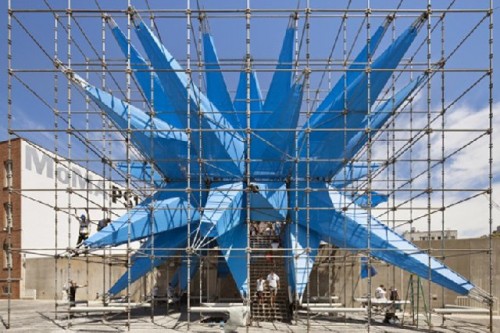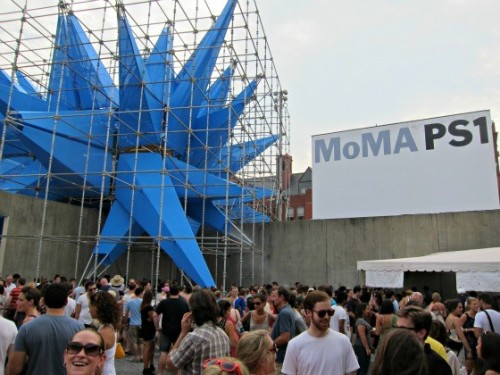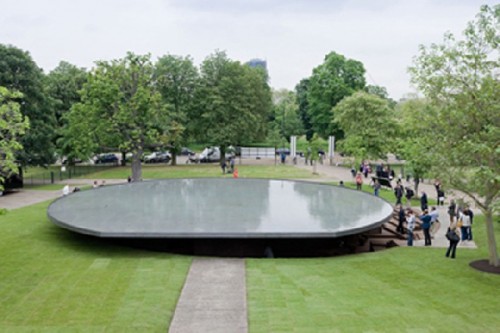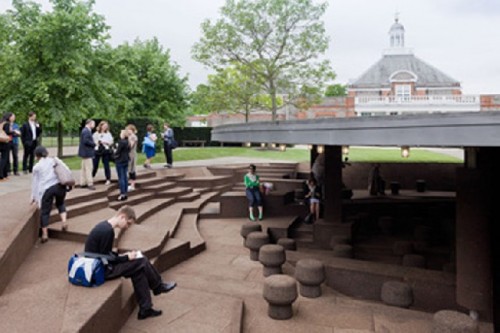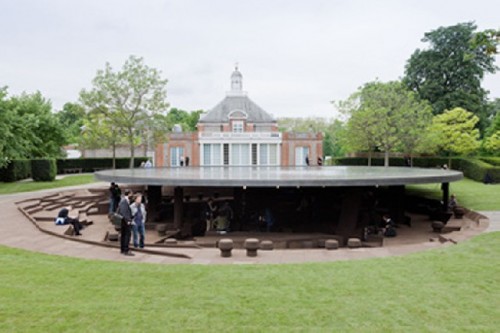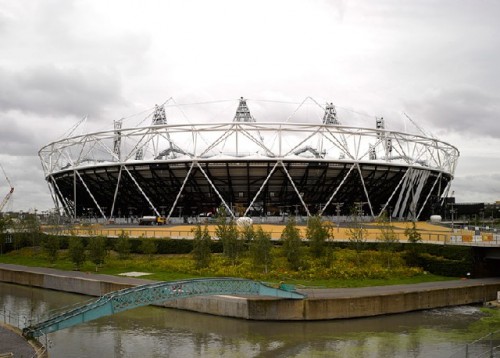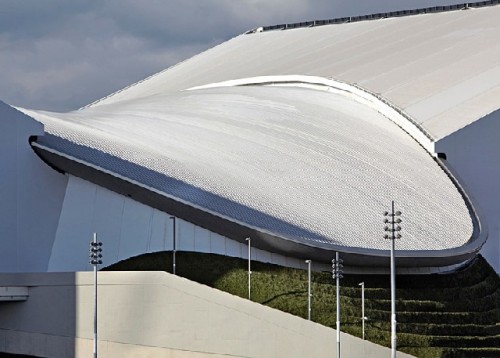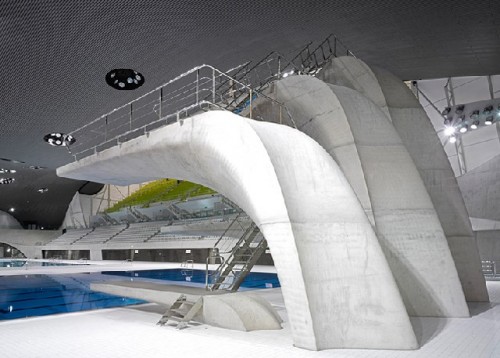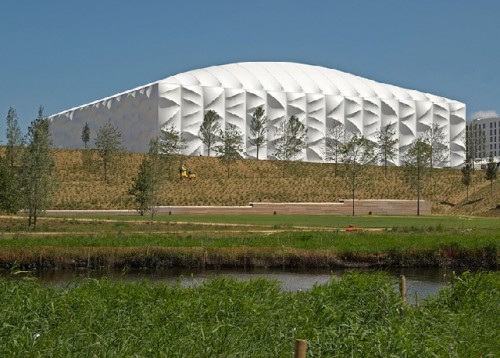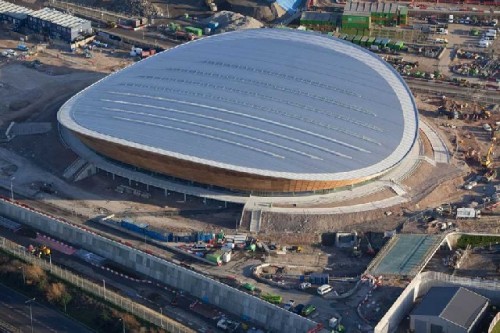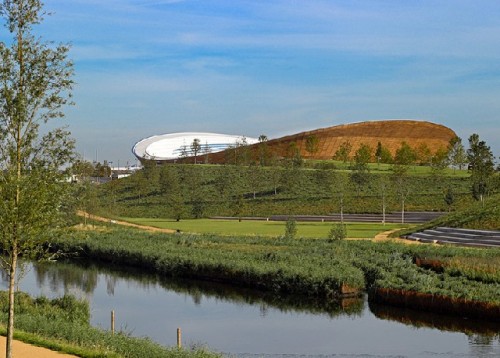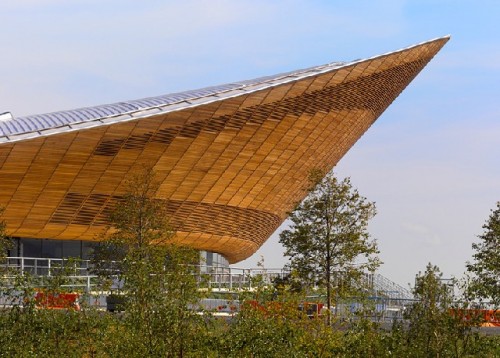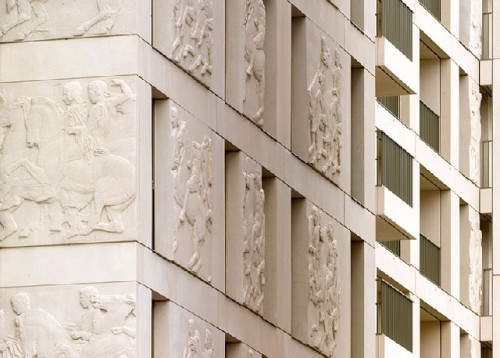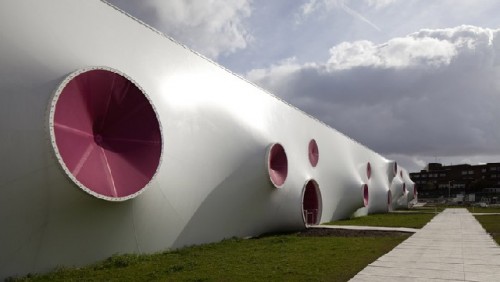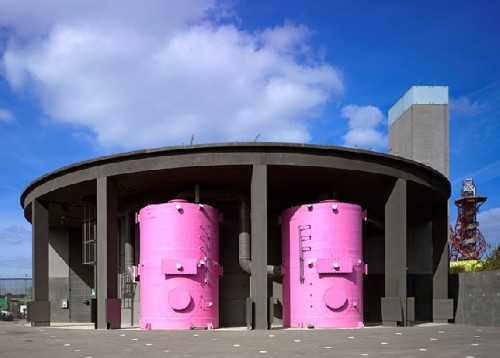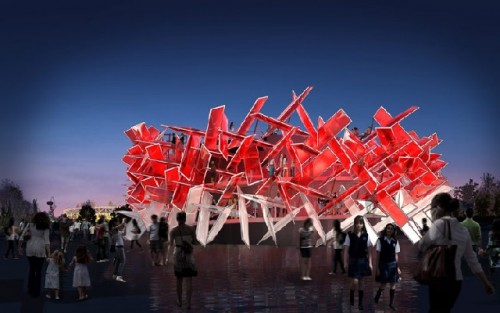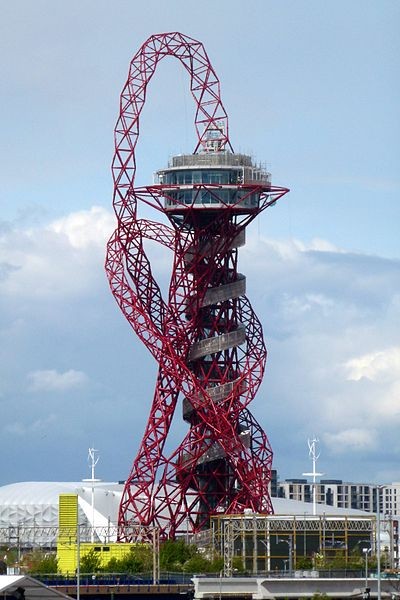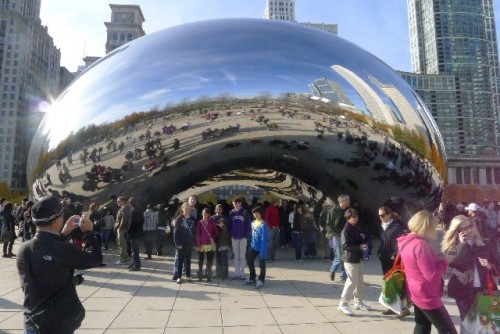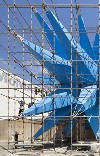Architecture As Sculpture in 2012
From PS 1 to China to the London Olympic Park
By: Mark Favermann - Aug 05, 2012
The best of contemporary architecture is conceived with beautiful form and strategic function in mind. Added to this old architectural chestnut (Thanks, Mies!) is the now ubiquitous integration of the environmental twins--sustainability and accessibility.
During the Summer of 2012, throughout the world, several notable structures, both temporary and permanent have been built and added to our environmental consciousness. Reviewing several wonderful structures from New York, London and China, we see that architecture as sculpture can be visually exciting functional art.
One very sculptural project is at MoMA's PS1 in NYC. Here, HWKN (Matthias Hollwich and Marc Kushner, New York) were the winners of the annual Young Architects Program (YAP) in New York coordinated by The Museum of Modern Art and MoMA PS1.
The Young Architects Program offers emerging architectural talent an opportunity to design and present innovative often cutting-edge projects.
It challenges each year’s winners to develop creative designs for a temporary, outdoor installation at the art complex that provides shade, seating, and water. The architects must work within guidelines that address environmental issues, including sustainability and recycling. HWKN designed a temporary urban landscape form for the 2012 institution's summer music series in MoMA PS1’s outdoor courtyard.
This year's winning project, Wendy, opened at MoMA PS1 in Long Island City on July 1, 2012. The blue star-burstlike structure is a thoughtful experiment that tests how far the boundaries of architecture can expand to create an ecological and social effect.
Wendy is composed of nylon fabric treated with a newly developed titania nanoparticle spray to neutralize airborne pollutants. This allows Wendy to clean the air of an equivalent of taking 260 cars off the road during its three month time at the site.
Wendy’s boundaries are defined by tools like shade, wind, rain, music, and visual identity to reach past the confines of physical limits. Wendy defines a total environment, not just a space. Spiky arms made of the nylon fabric will reach out with micro blasts of cool air, music, water cannons and mists to create social/physical zones throughout the courtyard.
Wendy is fabricated by a simple, inexpensive construction system. The main structure is a scaffold that forms a 70’ x 70’ x 45’ volume allowing the largest surface area possible. Wendy iscertainly architecture as sculpture.
The design team responsible for the celebrated 2008 Beijing Olympics stadium, the Bird's Nest, a now sorrowfully underused Beijing National Stadium, came together again in London in 2012 for the Serpentine Gallery's annual Temporary Pavilion commission. The 2012 Pavilion is Herzog & de Meuron and Ai Weiwei's first collaborative built structure in the United Kingdom. Open from June to October 2012, the Pavilion is one of the better parts of the London 2012 Festival, part of the 2012 Cultural Olympiad.
This year's Pavilion takes visitors beneath the Serpentine's lawn to explore hidden and historic elements of previous pavilions. Eleven columns characterising each past Pavilion and a twelfth column representing the current structure support a floating platform roof. The roof is set 1.5 metres above the ground. The Pavilion's interior is clad in cork, a sustainable building material chosen for its unique qualities and to echo the excavated earth.
Taking an archaeological approach, the architects and conceptual artist Ai Wei-wei have created a design that will inspire visitors to look beneath the surface of the park as well as back in time across the ghosts of the earlier structures. The Serpentine Gallery Pavilion operates as a public space and as a venue for the Gallery's program of public talks and events.
The 2012 Pavilion has been financially supported and purchased by billionaire steel magnate Lakshmi N. Mittal and will enter his private collection after it closes to the public in October 2012.
And this is a great segway into the 2012 London Olympic building structures.
Unlike many previous Olympics that had only one or two strongly designed sports venue structures, the 2012 London Olympics celebrated design by commissioning several structures, both temporary and permanent, as a major statement of its contemporary consciousness.
Strong visual memories of the 2008 Beijing Olympics are mostly about the previously mentioned Bird's Nest Olympic Stadium and the Waterdrop, swimming, diving and water polo venue. So recent precedence influenced the London Olympic Organizing Committee (LOOC). They wanted to create a state of the art Olympic Park.
Thoughtfully, the LOOC chose architects who designed beautiful contemporary elegantly stated structures. Many can be considered architecture as sculpture.
The venue for both opening and closing ceremonies and track & field (Athletics to the Brits) was the Olympic Stadium designed by Populous (formerly HOK Sports). If the Bird's Nest was ornate, the London Olympic Stadium was beautifully minimalist. It seated 80,000. Eventually, it will be reduced in size and become a soccer venue for London teams.
Set at the southern end of Olympic Park, the Olympic Stadium is the centrepiece of the 2012 London Olympic Games and its Paralympics. The stadium is "wrapped" in a pvc. This material encircles the 1000ft diameter structure and is approximately 66 ft high.
To create the stadium's roof, acompression truss and roof column connections were bolted together to allow for a very fast on-site assembly. This enables easy disassembling of the roof structure after the Games. The cable-supported roof structure covers approximately two thirds of the stadium's seating. In order to keep costs down, the roof covering was fabricated from non-toxic PVC material.
Though initially criticized as non-iconic by the architectural press, the 2012 Olympic Stadium looked magnificent during the games and especially on television--form and function intertwined.
The nearby Aquatic Centre has a presence all of its own. It looks a bit like a dolphin jumping or a fish swimming upstream. Designed by Dame Zaha Hadid's firm (she was recently elevated by Queen Elizabeth to dame for services to architecture), this is elegant sculptural form on the exterior and especially in the diving venue space on the interior.
The architect based her design concept on the fluid geometry of water. Taking notice of the nearby rivers, the undulating roof sweeps up from the ground level like a wave. It does this gesture while enclosing the various performance pools of the Centre. This is an exquiste building both from a distance and nearby.
The largest temporary structure at the 2012 Olympics was the Basketball Arena, dubbed The Mattressfor its shape and detailing. It is the largest temporary arena to be built for any Games. In order to keep costs down, the LOOC decided that this venue was to be only a temporary construction. Sinclair Knight Merz in partnership with Wilkinson Eyre and KSS designed the basketball arena. It went up the quickest of any major venue as well.
Seating 12,000, it underscores the notion that a temporary structure can also be epic architecture. It is certainly sculptural and iconic. Rio, the next Olympic city in 2016, will probably re-use it at their games. The Basketball Arena was also used to house athletes before the Opening and Closing ceremonies.
The Velodrome, the Olympic cycling venue, called The Pringle for its potato chip-like shape, is one of the most iconic of the Olympic venues. it is one of the four permanent venues on the Olympic Park, By using simple materials in an efficient manner to meet the client's aspirations as well as budget, it transcends functional architecture to be a brilliant sculptural form.
Inspired by the bicycle as an ingenious ergonomic object that is refined to the very outer limits of efficiency, the designs created a three dimensional building that reflects the functional requirements of the venue. These requirements are manifested in the structure's distinctive form. This a form that underscores the performance and efficiency of every aspect of the building function.
The stately Velodrome contains 6,000 seats with the upper and lower seating tiers being split by the main public circulation concourse. The concourse forms the main point of entry into the arena as well as allowing spectators to maintain contact with the action on the track.
The airy concourse is glassed enclosed to allow views both into and out of the building. It also helps to visually separate the Western Red Cedar clad upper bowl from the ground floor nearly hidden back of house accommodations. However, the iconic silhouette of the Velodrome is what makes it visually resonate.
This eloquent sculptural structure has already won several design awards including being shortlisted for the 2011 Sterling Prize. The building was designed by Hopkins Architects in collaboration with Expedition Engineering, BDSP and Grant Associates.
The Athletes' Village was a mini-city within a city. The compact design allows most of the sporting venues and the athletes’ village to be within walking distance. It is comprised of 11 apartment blocks with 2,818 apartments to accommodate the 16,000 athletes and officials who stayed there during the Games. After the Olympics, the apartments will be converted into 1600 affordable housing units for East Londoners.
Included was a temporay structure dining hall that sat up to 5,000. A hair salon, a recording studio, a games room, a movie room and other communal spaces that allowed athletes to mingle and relax. However the most striking and sculptural aspect of the Village are details borrowed from Ancient Greece, the origin of the Olympic Games. These details are reproductions of the Elgin Marbles. Controversies aside (and there are severe controversies attached to the 2500 year old Elgin Marbles), they have been reproduced in concrete by Niall McLaughlin Architects as a visual connection to the origins of the Olympics.
These recreated panels have been wrapped round the façade of buildings to adorn the various housing blocks. A visual if not literal bridge has been created: the old has been applied to the new to connect the past and the present symbolically and sculpturally.
The 2012 Olympic Shooting Venue is a unique temporary set of structures outside of the Olympic Park. The shooting venue is in Woolwich (part of Greenwich) on the grounds of the historic Royal Artillery Barracks. The three temporary buildings included 3.800 seats divided between two partially enclosed ranges for qualifying rounds and a fully enclosed finals range. All together, they make something of a campus.
Berlin based Magma Architecture created the dynamic and even fanciful shooting range. The structures exhibits a contemporary appeal outside and a more traditional aspect inside that features 10, 25, and 50 meter shooting galleries. The venue is composed of three dual layer PVC membranes that are held up by steel trusses. Music speaker-like indentions serve as doorways into the structure and ventilate the portable fabric edifice.
There is a whimsical quality to Magma's work which is displayed in the soft sculpture approach to the very distinctive Olympic Shooting Venue.
Smallest but not least is the Olympic Park Pumping Station. Together with a new sewer network, the station collected, conveyed and discharged waste from the main venues and buildings in the Olympic Park during the Games. Following the Games, it will serve legacy venues and residential developments in the same way. John Lyall Architects has brought a sense of grace and visual quality to one of the earthiest commissions, waste removal. Its obligatory 19th Century homage chimney is topped by a light box.
Now a decade and a half later, Coca-Cola has become more sophisticated. The BeatBox is built on the grounds of Olympic Park. Designed by the architect team of Asif Kahn and Pernilla Ohrstedt, the rather unexpected temporary pavilion is a red-and-white crystalline structure. It is formed by over 200 interlocked air cushions that trigger sound with touch or movement. It has a prickly pickup stix appearance, a little wild but controlled form. As visitors climbed the 656-foot long ramp to the top of the beatbox, they were able to create their own music by remixing the sounds of Olympic sports--splashes, footfalls, heartbeats, etc.
According to Asif Kahn, "The beat draws people in and allows them to personally experience sports through sound away from the main Games venues." This innovative interactive temporary structure combines architecture, music and technology. It was built as part of Coca-Cola's Future Flames campaign, a program to recognize London's talented youth.
Ironically, arguably the least pleasing sculptural building or element at the London Olympic Park is the one created by mega-artist Anish Kapoor, one of the greatest living sculptors. Though Kapoor can eloquently explain this asymmetrical monstrosity, no matter what his remarks about moving from light to darkness or darkness to light or that abstraction suggests origin, the Arcelormittal Orbit Tower is not visually compelling but repelling.
Unfortunately, it looks like an 11 year old kid got carried away with an old fashioned Erector Set somehow while using all the extra pieces without any concern for what it looked like except it is 377 feet high. Kapoor's favorite color is red, and that is the primary color of the Arcelormittal Orbit Tower. It was to be a physical statement of the 2012 Olympic Games that is quite misspoken.
Instead it is an over-engineered but ragged-looking tower structure as homage to the egos of the artist and its patron billionaire steel magnate Lakshmi N. Mittal. Since its model stage, it has been criticized. Kapoor and his engineer Balmond believe that Orbit represents a radical advance in the architectural field of combining sculpture and structural engineering. It will be interesting to see if this becomes a London sightseeing venue in the future or somehow just ignored the oddly configured hardware.
There are structures of interest beyond New York and London. With its white curving walls creating an infinite, borderless interior, Studio Pei-Zhu have designed a stunning structure, the Oct Design Museum in Shenzhen, China. The interior space casts no shadows and seems to have no depth.
The shiny silver exterior seems to pay tribute to Anish Kapoor's more mirrored "Bean" in Millennium Park in Chicago. The museum facade is punctuated by randomly scattered small triangular windows. The architects see the edifice as part of a cloud or dense fog with windows representing birds in flight. To most observers, it looks like a flying saucer that has landed.
A more or less surreal space that is a background for design exhibitions, the Oct Design Museum's agenda is to focus on fashion shows, product design, and conceptual automotive shows. The first floor of the building includes an entry lobby and café while the second and third floors are mainly exhibition spaces. Storage space is spread out evenly through the floors with movable walls allowing exhibition spaces to be extremely flexible in scale and function.
Set into its landscape, the building’s form seems to literally float above the ground, as if it was not from this planet (like a flying saucer?). Since the museum is 300 meters from the ocean, it also seems to reference sea smoothed stones found on a beach.This smooth stone shape have long been of interest to sculptors.
These various structure examples are expressions of architecture as sculpture. They are often a visual delight, some are strong sculptural silhouettes, others are very witty in form and substance and still others are more narrowly tasteful enhancements to our three dimensional urban fabric. Visually appealing and often viscerally provocative, these pieces of architecture as sculpture are literal gifts to our contemporary 21st Century built environment.

